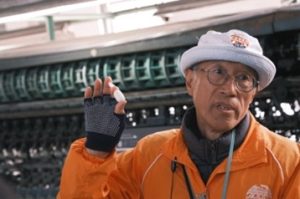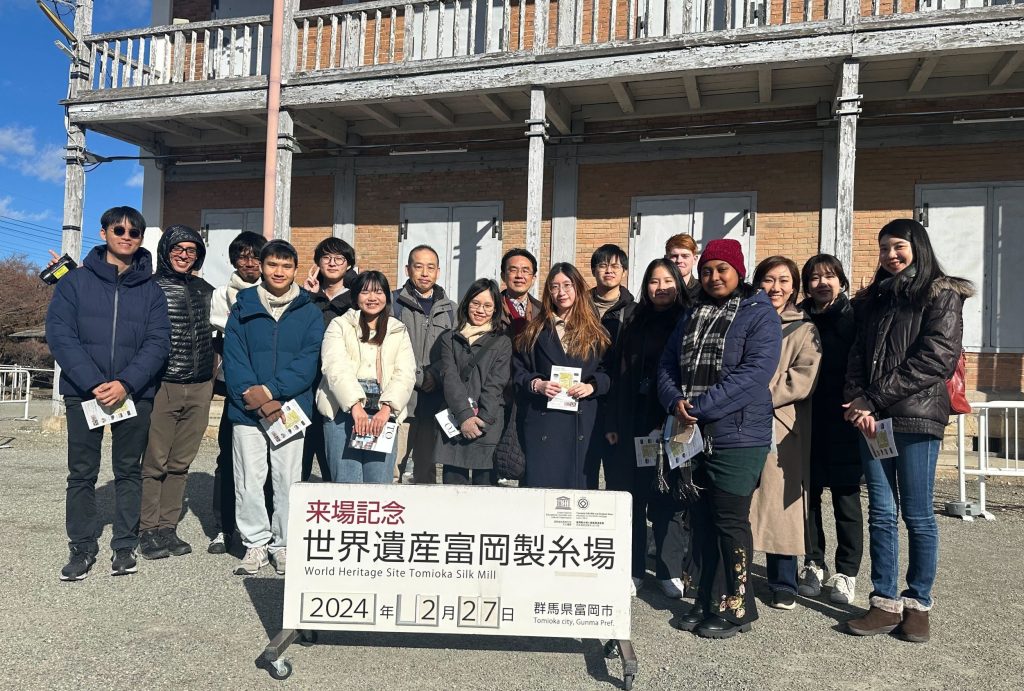In the second part of the series, Auksarapak Kietkajornrit and Thanakrit Yoongsomporn, then fourth-year students from Thailand, will share their experiences of visiting the Tomioka Silk Mill, a World Heritage Site in Gunma.
“In this trip, we had the opportunity to embark on an educational field trip to the Tomioka Silk Mill, a significant historical site in Japan that has played a pivotal role in the evolution of the silk industry. Our visit was facilitated by Motoharu Kondo, referred to from this point as Kondo-san, who proved to be an invaluable guide, offering us a comprehensive tour of the world heritage site. Despite the fact that certain areas of the mill were inaccessible due to ongoing renovations, the portions we were able to explore provided us with profound insights into the silk production process and its historical context.
Upon our arrival, we started our tour with a group photograph. Kondo-san then led us to the cocoon warehouse, where he shared details about its unique construction. The warehouse’s design, influenced by foreign architectural techniques, incorporates a strategic brick arrangement and an abundance of windows. This design was intentional, aimed at ensuring optimal air circulation to maintain the quality of the stored cocoons, a critical factor in silk production. This early part of our visit highlighted the blend of Japanese and foreign innovations that characterize the mill’s history.

Our exploration continued as we proceeded to the silk reeling plant, where Kondo-san elaborated on the transformative advancements in silk production in Japan. Initially reliant on manual labor, the introduction of machinery—initially brought from abroad—marked a significant turning point in the industry. Japan’s subsequent development of its own machinery further enhanced productivity and efficiency. At its latest version, the lengthy machine only requires two people to operate it effectively. Kondo-san provided us with a tangible connection to this history by allowing us to feel the textures of both different kinds of silk, an experience that underscored the remarkable transformation the silk industry undergoes.

As we navigated the grounds, passing by buildings that once served as dormitories, offices, and houses for the workers, Kondo-san enriched our understanding with anecdotes and historical trivia. These stories, ranging from rumors about wine consumption to the provision of basic education for the mill’s workers, painted a vivid picture of the community and culture that thrived within the mill’s complex.
The culmination of our tour was the visit to the silk gallery, a repository of knowledge where the mill’s legacy is meticulously documented. The gallery housed detailed models and displays, including explanations of the mechanisms behind air circulation critical to silk production. Although we did not purchase souvenirs, the presence of a shop offering a variety of silk products underscored the enduring craftsmanship and heritage of the Tomioka Silk Mill.

Reflecting on our visit, it’s clear that the Tomioka Silk Mill stands as a testament to Japan’s journey towards modernization and its historical significance in the global silk industry. Kondo-san’s guidance provided us not only with a historical overview but also with a sense of connection to the people and processes that have shaped the mill’s storied past. This field trip extended beyond a mere academic excursion; it was a journey that bridged the gap between history and present-day realities, leaving us with a deeper appreciation for the intricate blend of tradition, innovation, and human endeavor that defines the Tomioka Silk Mill. Despite the limitations imposed by the renovations, the experience was both enlightening and memorable, offering us insights that we will carry forward in our academic pursuits and beyond.”

